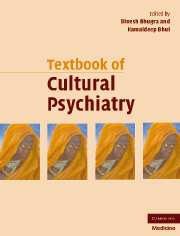Book contents
- Frontmatter
- Contents
- Contributors
- Foreword
- Preface
- Part I Theoretical background
- Part II Culture and mental health
- 8 Culture and psychopathology: general view
- 9 Developmental aspects of cultural psychiatry
- 10 Explanatory models in psychiatry
- 11 Culture-bound syndromes: a re-evaluation
- 12 Psychiatric epidemiology and its contributions to cultural psychiatry
- 13 Acculturation and identity
- 14 Cultural consonance
- Part III Culture and mental disorders
- Part IV Theoretical aspects of management
- Part V Management with special groups
- Part VI Cultural research and training
- Cultural psychiatry: the past and the future
- Index
- References
11 - Culture-bound syndromes: a re-evaluation
from Part II - Culture and mental health
Published online by Cambridge University Press: 11 August 2009
- Frontmatter
- Contents
- Contributors
- Foreword
- Preface
- Part I Theoretical background
- Part II Culture and mental health
- 8 Culture and psychopathology: general view
- 9 Developmental aspects of cultural psychiatry
- 10 Explanatory models in psychiatry
- 11 Culture-bound syndromes: a re-evaluation
- 12 Psychiatric epidemiology and its contributions to cultural psychiatry
- 13 Acculturation and identity
- 14 Cultural consonance
- Part III Culture and mental disorders
- Part IV Theoretical aspects of management
- Part V Management with special groups
- Part VI Cultural research and training
- Cultural psychiatry: the past and the future
- Index
- References
Summary
EDITORS' INTRODUCTION
For over a century, cultures in traditional societies were seen as providing exotic and esoteric clinical conditions, which were not ‘seen’ in other cultures. The history of clinical anthropology followed two different routes in Western Europe and North America. By and large in the colonial times the anthropologists studied the ruled populations, whereas in North America the focus was on native and aboriginal groups. As a result, the clinicians who went to work in the colonies decided that certain conditions occurred only as a result of civilizations and that the colonialized people could possible not suffer from these. On the other hand, conditions were seen ‘exclusively’ in certain ethnic groups and were a result of under development of the brain and the behaviour was uncivilized. Amok, seen in the Malay archipelago, was criminalized by the British. Consequently, a previously acceptable social behaviour was criminal behaviour and all those who suffered from it were sent to prison. There is clear evidence that a similar response is seen in other cultures but not seen as criminal.
Using amok among other so-called culture-bound syndromes, Bhugra and colleagues set the scene on the development of the concept of culture-bound syndromes. They argue that all psychiatric syndromes are affected by culture and are within this boundedness. Running amok in the Far East is no different from individuals taking guns and shooting randomly and indiscriminately at school children. Latah has similar hyperstartle response in other cultures. Dhat or semen-loss anxiety as seen in culture-bound manner in the Indian subcontinent has been historically reported in so-called developed countries.
- Type
- Chapter
- Information
- Textbook of Cultural Psychiatry , pp. 141 - 156Publisher: Cambridge University PressPrint publication year: 2007
References
- 10
- Cited by

